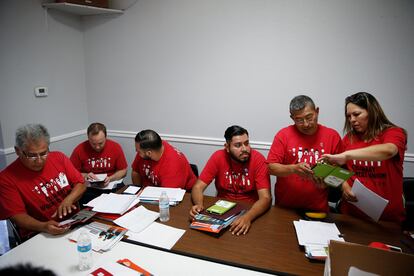From language requirements to time restrictions: The long history of opposition to the Latino vote in the US
Hispanic voters participate the least in elections, and not only because of their alleged political apathy. Despite federal protections, states have implemented rules to make access to voting more difficult

The intent of the requirement was not concealed: to block the “ignorant Mexican vote.” This was stated bluntly in a local newspaper editorial that strongly advocated for the passage of a measure in Arizona in 1909 that required taking an English literacy test to be eligible to vote. Since the end of the Civil War and slavery in the United States, laws had been pushed in territories across the country to restrict voting among Black people, and within a few decades strategies began to be adapted to limit access to voting for the Latino population as well. In addition to language tests, some states imposed special taxes to exclude the lower classes, or else racial discrimination measures that were not illegal at the time. Thus, for as long as records exist, Latinos have consistently been the group that votes in the lowest proportion. The difference is known as the Turnout Gap and behind it is not only an alleged political apathy or failed assimilation, but a long offensive to suppress the Latino vote.
Even the Voting Rights Act of 1965, passed at the height of the civil rights movement, did not end suppression. While the legislation, which ensured that anyone born or naturalized in the United States had the right to vote and prohibited states from depriving voters of the right “on account of race, color, or previous condition of servitude,” was aimed at the African-American population that had suffered decades of segregation in the South, it also benefited the growing Latino population. Even more so when the law was expanded in 1975 following efforts by Latino organizations and activists to include protections for “linguistic minorities,” as many language restrictions remained in effect. Since then, it has been possible to translate election material into Spanish, and also into other languages, opening the door to thousands of new voters.
The law included “special provisions” that applied to specific jurisdictions. The most relevant was “preclearance,” which applied to states with a history of suppressing minority votes and dictated that the Attorney General or the District Court in Washington must approve any changes to election rules to ensure that no new rules disproportionately affect a particular group. However, in light of the legal reinforcements, new ways of restricting voting were devised that at first glance do not have the objective of suppressing the vote of Latinos and other minorities, but in practice do exactly that. This category includes “gerrymandering,” which is the redistribution of electoral districts to minimize the impact of minority votes, although this had been done for a long time. And although participation increased gradually among Latinos, from 30% until 2000 to over 50% in 2020, it remained almost 20 points below the average.
During that time, however, there was some important action on the legal front. In 2013, the Supreme Court made a key decision. In its 5-4 ruling in Shelby County, Alabama v. Holder, it struck down preclearance from the Voting Rights Act. Justice John Roberts wrote for the majority that while the Voting Rights Act had been necessary in the past, it was no longer needed and was therefore unconstitutional because it placed too much of a burden on the States. In a dissent, Justice Ruth Bader Ginsburg replied: “Throwing out preclearance when it has worked and is continuing to work to stop discriminatory changes is like throwing away your umbrella in a rainstorm because you are not getting wet.”
Within 24 hours, Texas, Mississippi and Alabama introduced strict voter ID laws, which disproportionately affected minorities. For example, in Texas only some official IDs are allowed, such as a gun permit, but not a college student ID. Beto O’Rourke, a former Democratic representative in the House for the state, issued his own verdict: “For 144 years, Texas has perfected the science of voter suppression at the polls.”
And since Donald Trump burst onto the political scene a little less than a decade ago and spread unsubstantiated conspiracy theories of massive voter fraud involving non-citizen immigrants, efforts to suppress the Latino vote have only intensified. In 2019, Texas state officials singled out 95,000 voters they identified as “non-citizens” and accused them of voter fraud. After a review, it turned out that many of those individuals were naturalized and did indeed have the right to vote.
In 2021, Republican Governor Greg Abbott signed SB1 into law, which bans 24-hour voting, eliminates drive-thru voting, establishes new ID mandates for mail-in voting, makes it a felony for public officials to widely mail ballots, gives more power to partisan poll watchers, and requires the Texas Secretary of State to conduct monthly checks of voter rolls. These provisions directly impact the Latino electorate, who benefited from expanded voting methods, as their work schedules often make it impossible for them to go to a polling station on Election Day.
When Abbott approved that there should be only one ballot box per county to collect mail-in ballots, supposedly to “protect the integrity of the election and stop illegal voting,” he received numerous criticisms, including a lawsuit from LULAC, one of the oldest organizations that watch over the rights of Latinos in the country. The judge of Harris County, one of the most populous in the nation and with a majority Hispanic population, spoke out via Twitter, noting that the county is larger than Rhode Island: “This is not security, it is suppression.” But it is not just Texas: in many other states, such as Kansas, Ohio or Georgia, similar rules have been approved recently.
In the last week, the issue has come back into focus with more controversies centered on Texas. On the one hand, LULAC has accused the attorney general, Ken Paxton, of criminalizing the Hispanic vote after house searches of Latino leaders in which local prosecutors entered the homes of Democratic supporters and activists of the organization as part of an investigation into alleged “electoral fraud” and “vote planting.” The director of LULAC in Texas, Gabriel Rosales, insisted that Paxton’s investigation and intimidation will not stop them. “We are going to continue working on this, no matter what this AG thinks he is going to do. It will only add more fuel for us to continue doing what we know. We have not broken any law. All we have done is go out to increase the participation of the Latino community,” he said.
Abbott also announced this week that since he signed the new package of laws aimed at restricting voting in 2021, more than a million names have been removed from the list of potential voters, mostly people who moved out of the state, who have died, or whose whereabouts cannot be confirmed. And although only 6,500 of the removed voters correspond to people without U.S. citizenship, Abbott’s focus was on alleged “illegal voting.”
Despite the obstacles that have been historically put in place and which have intensified in some states in recent years, as well as the attempts to undermine confidence in the process, the Latino electorate is growing more than any other, simply due to demographic inertia. And a larger population, better assimilated than in the past and more organized, has the capacity to confront the imposed obstacles and is expected to bring more Latinos to the polls than ever before.
Sign up for our weekly newsletter to get more English-language news coverage from EL PAÍS USA Edition
Tu suscripción se está usando en otro dispositivo
¿Quieres añadir otro usuario a tu suscripción?
Si continúas leyendo en este dispositivo, no se podrá leer en el otro.
FlechaTu suscripción se está usando en otro dispositivo y solo puedes acceder a EL PAÍS desde un dispositivo a la vez.
Si quieres compartir tu cuenta, cambia tu suscripción a la modalidad Premium, así podrás añadir otro usuario. Cada uno accederá con su propia cuenta de email, lo que os permitirá personalizar vuestra experiencia en EL PAÍS.
¿Tienes una suscripción de empresa? Accede aquí para contratar más cuentas.
En el caso de no saber quién está usando tu cuenta, te recomendamos cambiar tu contraseña aquí.
Si decides continuar compartiendo tu cuenta, este mensaje se mostrará en tu dispositivo y en el de la otra persona que está usando tu cuenta de forma indefinida, afectando a tu experiencia de lectura. Puedes consultar aquí los términos y condiciones de la suscripción digital.
More information
Archived In
Últimas noticias
Most viewed
- Sinaloa Cartel war is taking its toll on Los Chapitos
- Oona Chaplin: ‘I told James Cameron that I was living in a treehouse and starting a permaculture project with a friend’
- Reinhard Genzel, Nobel laureate in physics: ‘One-minute videos will never give you the truth’
- Why the price of coffee has skyrocketed: from Brazilian plantations to specialty coffee houses
- Silver prices are going crazy: This is what’s fueling the rally











































